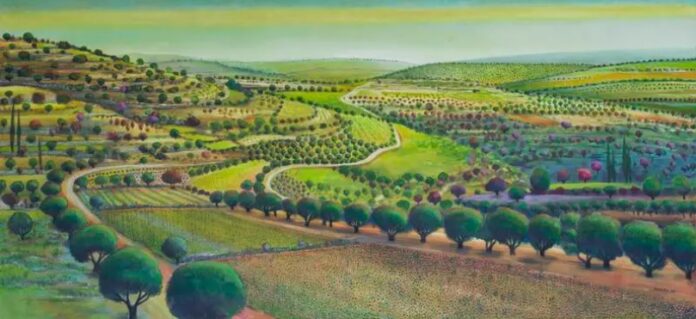
At the center of the Palazzo Mora in Venice is a live olive grove strewn with keys. Each key represents a Palestinian displaced during the mass evictions in 1948 and symbolize the intention to return home one day. A historic map of Palestine blankets the gallery floor; overhead, speakers play Palestinian oral histories spliced with traditional music.
All of this is part of a new exhibition dedicated to Palestinian art. Titled “From Palestine with Art,” the show was organized by the Palestine Museum US, a Connecticut-based nonprofit dedicated to showcasing Palestinian art and history.
Nineteen Palestinian artists, a mix of artists currently based in Palestine and those part of its diaspora, as well as established and emerging, are featured in the show, which looks to show “the enduring beauty of Palestine” and aims to help the artists earn “their deserved place in the global arts arena,” said Nancy Nesvat, the museum’s head curator.
Among the well-known artists included are Samia Halaby, a Jerusalem-based abstract painter, activist, and scholar, and Latroun-born Nabil Anan, a prominent figure painter, ceramicist, and sculptor considered a pioneer of contemporary Palestinian art.
“This gives us a great opportunity to fulfill our mission of celebrating and showcasing Palestinian artistic excellence and telling the Palestinian story to a global audience through the arts,” Faisal Saleh, a businessman who founded the Palestine Museum US in 2018, said in a statement.
The museum remains the only institution in the United States solely dedicated to preservation of Palestinian art and culture. The museum maintains a “nonpolitical” program of lectures, film screenings, and art-making workshops. Recent exhibitions include a show of work by contemporary Palestinian women and a multimedia survey of living and historic artists, including sculptures by Muhammed Al Haj, portraits by Jacqueline Bejani, and landscapes of Palestine by Nahla Asia.
This year’s Biennale marks the museum’s inaugural exhibition at the prestigious international art festival, where in addition to the main exhibition, numerous countries mount exhibitions in their own dedicated national pavilions.
Because of Palestine’s contested statehood by the West (only 138 of the U.N.’s 193 members recognize the country as of 2019), organizers have in the past grappled with how exactly to present Palestinian art during the Biennale. In its 127-year-history, the event has never had an official national pavilion for Palestine. (Other territories without national pavilions that mount official collateral events during the Biennale include, this year, Hong Kong, Scotland, and Taiwan.)
In 2002, curator Francesco Bonami, who served as the artistic director for the 2003 edition, suggested to the Biennale’s board that they consider adding a Palestinian Pavilion to the upcoming exhibition. The idea was short-lived: the next morning a scathing article in Il Gazzettino, a major daily newspaper in Venice, accused Bonami of courting anti-Semitism. Instead, Bonami opted to include an installation work titled Stateless Nation, comprising various large-scale passports, designed by Palestinian architect Sandi Hilal and her Italian husband, Alessandro Petti.
In 2007, Emily Jacir, who lives and works in New York and Ramallah, became the only Palestinian artist to be awarded the Golden Lion, the highest honor awarded to an individual participant, for her large-scale mixed media installation Material for a Film, honoring the life of Palestinian poet and translator Wael Zuaiter, who was killed near his apartment in Rome by Mossad agents in 1972 as part of a series of assassinations carried out by Israeli agents on Palestinian artists, intellectuals, and diplomats.
Thirteen bullets were fired at Zuaiter, the last of which pierced the book he was carrying, A Thousand and One Nights and lodged in its spine. Zuaiter was working on translating the book before his murder; “to this day an Italian translation from the Arabic does not exist,” Jacir wrote in her artist statement for the installation, which displayed a copy of the book. In their statement, jurors wrote of the Material for a Film: “Without recourse to exoticism, the work on display in the central Pavilion at the Giardini establishes and expands a crossover between cinema, archival documentation, narrative and sound.”
The following year Jacir, who operates the Dar Yusuf Nasri Jacir for Art and Research, in Bethlehem, took home the Guggenheim Museum’s prestigious Hugo Boss Prize.
In 2009, the exhibition “Palestine c/o Venice” was admitted as the Biennale’s first official collateral event on Palestinian art. Curated by Salwa Mikdadi, it reflected on the harsh realities of Palestinians living under Israeli occupation, or “chronic impermanence, a condition Palestinians surmount with creative resistance as they reclaim their place as art practitioners free from the political essentialism that defines the media representation of their aesthetics,” according to the exhibition catalogue.
The perseverance of Palestinian art at Venice makes a good case against the relevance of national pavilions in a transnational art community. In 2019, Larissa Sansour represented Palestine in the Danish Pavilion with the film In Vitro, a black-and-white vision of the climate apocalypse set in Bethlehem. Last year, architects Elias and Yousef Anastas, co-founders of the architectural firm Aau Anastas, presented their work All Purpose, a pavilion whose vaulted roof was made of Palestinian limestone, at the Venice Architecture Biennale.
“From Palestine with Art” features a broad range of art in various mediums. Haifa-based Sana Farah Bishara has bronze sculptures of abstracted figures similar to ones installed in public spaces across Palestine. Rania Matar, a 2018 Guggenheim Fellow, presents photographs that explore her interest in the intersection of identity, individuality, and gender in the Middle East and U.S., while Oklahoma-based Hanan Awad presents street photography. Multidisciplinary artist Ibrahim Alazza often utilizes Palestinian cultural touchstones and artifacts to investigate the country’s collective memory.
“Palestinian artists are producing excellent work under severe conditions, including bombings,” Saleh recently told the National. “We want to have the artwork speak, just like any other work from elsewhere.”
























